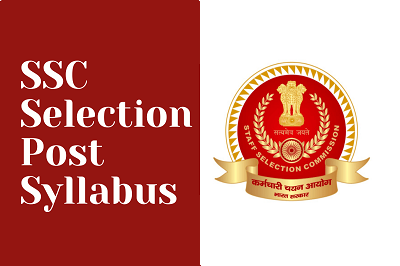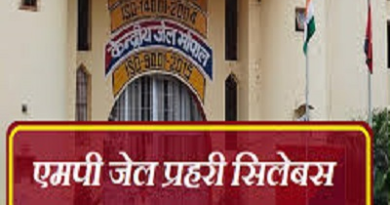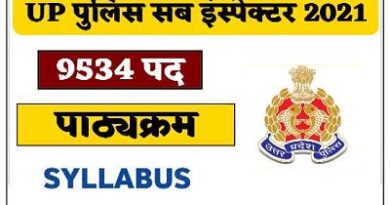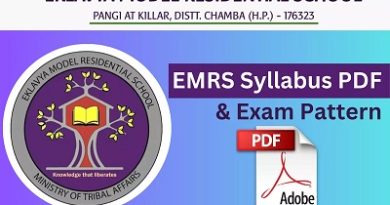SSC JE Syllabus 2023 – नए बदलाव के साथ एसएससी जूनियर इंजीनियर एग्जाम का पूरा सिलेबस
SSC JE Syllabus 2023 in Hindi Pdf Download
SSC JE Syllabus in Hindi
SSC JE Exam Pattern 2023
Exam Pattern Tier l
- परीक्षा मे कुल 200 प्रश्न पूछे जाएंगे।
- परीक्षा अधिकतम 200 नंबर की होंगी।
- इस एग्जाम में प्रत्येक प्रश्न 1 नंबर का होता हैं।
- प्रत्येक गलत उत्तर के लिए ¼ नेगेटिव मार्किंग होता हैं।
- कुल समय अवधि 120 मिनट रहेगी।
| भाग | विषय | प्रश्नों की संख्या | अंक | समय |
| (1) | जनरल इंटेलिजेंस एंड रीजनिंग | 50 | 50 | 120 मिनट |
| जनरल अवेयरनेस | 50 | 50 | ||
| (2) | जनरल इंजीनियरिंग (सिविल एंड स्ट्रक्चरल) या | 100 | 100 | |
| जनरल इंजीनियरिंग (इलेक्ट्रिकल) या | ||||
| जनरल इंजीनियरिंग (मैकेनिकल) |
Exam Pattern Tier ll
- पेपर-2 एक वर्णनात्मक पेपर (Descriptive Paper) होता है, इसमें आपको डिस्क्रिप्टिव टाइप के सवाल पूछे जाते हैं।
- यह पेपर कुल 300 अंकों का होता हैं।
- पेपर-2 की समय अवधि भी 2 घंटे हैं।
- पेपर 2 में कोई नेगेटिव मार्किंग नहीं होती हैं।
- उम्मीदवारों को पेपर-2 में Part A- Civil & Structural Engineering, Part B- Electrical Engineering और Part C- Mechanical Engineering में से किसी एक विषय के विकल्प को चुनना होता हैं।
| भाग | विषय | अंक | 120 मिनट |
| (1) | जनरल इंजीनियरिंग (सिविल एंड स्ट्रक्चरल) या | 300 | |
| जनरल इंजीनियरिंग (इलेक्ट्रिकल) या | |||
| जनरल इंजीनियरिंग (मैकेनिकल) |
SSC JE Syllabus Paper II In Hindi
Paper 1 – रीजनिंग
- सादृश्यता
- समानताएं
- अंतर
- अंतरिक्ष दृश्य
- प्रश्न हल करना
- विश्लेषण
- निर्णयन
- निर्णय क्षमता
- दृश्य स्मृति
- विषम
- पर्यवेक्षण
- संबंध अवधारणाएं
- अंकगणितीय तर्क
- मौखिक और आकृति वर्गीकरण
- अंकगणितीय संख्या श्रृंखला आदि
- इस परीक्षा में अमूर्त विचारों और प्रतीकों और उनके संबंधों, अंकगणितीय गणनाओं और अन्य विश्लेषणात्मक कार्यों से निपटने के उम्मीदवार की क्षमताओं का परीक्षण करने के लिए डिज़ाइन किए गए प्रश्न भी शामिल होंगे।
Paper 1 – सामान्य अध्ययन
पेपर 1 के लिए SSC JE सिलेबस में उम्मीदवारों के सामान्य ज्ञान की जांच के लिए इतिहास, राजनीति, भूगोल, अर्थशास्त्र, पर्यावरण, विज्ञान, करंट अफेयर्स आदि के सभी विषय शामिल हैं –
- प्रश्नों का उद्देश्य उम्मीदवार को उसके/उसके समाज के परिवेश के बारे में सामान्य जागरूकता का परीक्षण करना होगा।
- प्रश्नों को वर्तमान घटनाओं के ज्ञान का परीक्षण करने के लिए डिज़ाइन किया जाएगा, और
- किसी भी शिक्षित व्यक्ति से अपेक्षा की जा सकती है कि वह उनके वैज्ञानिक पहलू को समझता हो।
- इस टेस्ट में भारत और उसके पड़ोसी देशों से संबंधित प्रश्न भी शामिल होंगे, विशेष रूप से इतिहास, संस्कृति, भूगोल, आर्थिक दृश्य, सामान्य राजनीति और वैज्ञानिक अनुसंधान, आदि से संबंधित।
- ये सवाल ऐसे होंगे कि उन्हें किसी विशेष अनुशासन के अध्ययन की आवश्यकता नहीं हैं।
Paper 1 – अभियांत्रिकी सम्बंधित विषय
भाग – (A) सिविल इंजीनियरिंग –
- Building Materials
- Estimating
- Costing and Valuation
- Surveying
- Soil Mechanics
- Hydraulics
- Irrigation Engineering
- Transportation Engineering
- Environmental Engineering
- Structural Engineering: Theory of Structures, Concrete Technology, RCC Design, Steel Design.
भाग – (B) इलेक्ट्रिकल इंजीनियरिंग –
- Basic concepts
- Circuit law
- Magnetic Circuit
- AC Fundamentals
- Measurement and Measuring instruments
- Electrical Machines
- Fractional Kilowatt Motors and single phase induction Motors
- Synchronous Machines
- Generation
- Transmission and Distribution
- Estimation and Costing
- Utilization and Electrical Energy
- Basic Electronics.
भाग – (C) मैकेनिकल इंजीनियरिंग –
- Theory of Machines and Machine Design
- Engineering Mechanics and Strength of Materials
- Properties of Pure Substances
- 1st Law of Thermodynamics
- 2nd Law of Thermodynamics
- Air standard Cycles for IC Engines
- IC Engine Performance
- IC Engines Combustion
- IC Engine Cooling & Lubrication
- Rankine cycle of System
- Boilers
- Classification
- Specification
- Fitting & Accessories
- Air Compressors & their cycles
- Refrigeration cycles
- Principle of Refrigeration Plant
- Nozzles & Steam Turbines
- Properties & Classification of Fluids
- Fluid Statics
- Measurement of Fluid Pressure
- Fluid kinematics
- Dynamics of Ideal fluids
- Measurement of Flow rate
- basic principles
- Hydraulic Turbines
- Centrifugal Pumps
- Classification of steels.
SSC JE Syllabus Paper II In Hindi
Paper 2 – सिविल और स्ट्रक्चरल इंजीनियरिंग (भाग-A)
- Civil Engineering :भवन निर्माण सामग्री – भौतिक और रासायनिक गुण, वर्गीकरण, मानक परीक्षण, उपयोग और सामग्री का निर्माण/उत्खनन। भवन निर्माण के पत्थर, सिलिकेट आधारित सामग्री, सीमेंट (पोर्टलैंड), एस्बेस्टस उत्पाद, लकड़ी और लकड़ी आधारित उत्पाद, लेमिनेट, बिटुमिनस सामग्री, पेंट, वार्निश।
- Estimating, Costing and Valuation –अनुमान, तकनीकी शब्दों की शब्दावली, दरों का विश्लेषण, माप की विधियां और इकाई, काम की वस्तुएं – मिट्टी का काम, ईंट का काम (मॉड्यूलर और पारंपरिक ईंटें), आरसीसी का काम, शटरिंग, लकड़ी का काम, पेंटिंग, फर्श, पलस्तर करना। सीमा दीवार, ईंट निर्माण, पानी की टंकी, सेप्टिक टैंक, बार झुकने का शेड्यूल, केंद्र रेखा विधि, मध्य-खंड सूत्र, ट्रेपेज़ोडियल सूत्र, सिम्पसन का नियम। सेप्टिक टैंक, लचीले फुटपाथ, ट्यूबवेल, आइसोलेट्स और संयुक्त फ़ुटिंग्स, स्टील ट्रस, पाइल्स और पाइल-कैप की लागत का अनुमान। मूल्यांकन – मूल्य और लागत, स्क्रैप मूल्य, बचाव मूल्य, मूल्यांकन मूल्य, डूबती निधि, मूल्यह्रास और अप्रचलन, मूल्यांकन के तरीके।
- Surveying – सर्वेक्षण के सिद्धांत, दूरी की माप, श्रृंखला सर्वेक्षण, प्रिज्मीय कम्पास का कार्य, कम्पास ट्रैवर्सिंग, बीयरिंग, स्थानीय आकर्षण, प्लेन टेबल सर्वेक्षण, थियोडोलाइट ट्रैवर्सिंग, थियोडोलाइट का समायोजन, लेवलिंग, लेवलिंग, समोच्च, वक्रता और में प्रयुक्त शब्दों की परिभाषा अपवर्तन सुधार, डंपी स्तर का अस्थायी और स्थायी समायोजन, समोच्च के तरीके, समोच्च मानचित्र का उपयोग, टैकोमेट्रिक सर्वेक्षण, वक्र सेटिंग, पृथ्वी कार्य गणना, उन्नत सर्वेक्षण उपकरण।
- Soil Mechanics –मिट्टी की उत्पत्ति, चरण आरेख, परिभाषाएँ-शून्य अनुपात, सरंध्रता, संतृप्ति की डिग्री, पानी की मात्रा, मिट्टी के दानों का विशिष्ट गुरुत्व, इकाई वजन, घनत्व सूचकांक और विभिन्न मापदंडों का अंतर्संबंध, अनाज का आकार वितरण वक्र और उनके उपयोग। मिट्टी के सूचकांक गुण, एटरबर्ग की सीमाएं, आईएसआई मिट्टी वर्गीकरण और प्लास्टिसिटी चार्ट। मिट्टी की पारगम्यता, पारगम्यता का गुणांक, पारगम्यता के गुणांक का निर्धारण, असंबद्ध और सीमित जलभृत, प्रभावी तनाव, त्वरित रेत, मिट्टी का समेकन, समेकन के सिद्धांत, समेकन की डिग्री, पूर्व-समेकन दबाव, सामान्य रूप से समेकित मिट्टी, ई-लॉग पी वक्र, अंतिम निपटान की गणना। मिट्टी की कतरनी शक्ति, प्रत्यक्ष कतरनी परीक्षण, वेन कतरनी परीक्षण, त्रिअक्षीय परीक्षण। मृदा संघनन, प्रयोगशाला संघनन परीक्षण, अधिकतम शुष्क घनत्व और इष्टतम नमी सामग्री, पृथ्वी दबाव सिद्धांत, सक्रिय और निष्क्रिय पृथ्वी दबाव, मिट्टी की वहन क्षमता, प्लेट लोड परीक्षण, मानक प्रवेश परीक्षण।
- Hydraulics – द्रव गुण, हाइड्रोस्टैटिक्स, प्रवाह की माप, बर्नौली का प्रमेय और इसका अनुप्रयोग, पाइपों के माध्यम से प्रवाह, खुले चैनलों में प्रवाह, वियर, फ्लूम, स्पिलवे, पंप और टर्बाइन।
- Irrigation Engineering –परिभाषा, आवश्यकता, लाभ, सिंचाई के प्रभाव, सिंचाई के प्रकार और तरीके, जल विज्ञान – वर्षा का माप, अपवाह गुणांक, वर्षामापी, वर्षा से हानि – वाष्पीकरण, अंतःस्राव, आदि। फसलों की जल आवश्यकता, कर्तव्य, डेल्टा और आधार अवधि , खरीफ और रबी फसलें, कमांड क्षेत्र, समय कारक, फसल अनुपात, ओवरलैप भत्ता, सिंचाई क्षमता। विभिन्न प्रकार की नहरें, नहर सिंचाई के प्रकार, नहरों में पानी की कमी। नहर लाइनिंग – प्रकार और फायदे। उथले और गहरे कुओं तक, एक कुएं से उपज। वियर और बैराज, वियर की विफलता और पारगम्य नींव, स्लिट और स्कॉर, कैनेडी का क्रांतिक वेग का सिद्धांत। लेसी का एकसमान प्रवाह का सिद्धांत. बाढ़ की परिभाषा, कारण एवं प्रभाव, बाढ़ नियंत्रण के तरीके, जल भराव, निवारक उपाय। भूमि पुनर्ग्रहण, मिट्टी की उर्वरता को प्रभावित करने की विशेषताएं, उद्देश्य, विधियाँ, भूमि का विवरण और पुनर्ग्रहण प्रक्रियाएँ। भारत में प्रमुख सिंचाई परियोजनाएँ।
- Transportation Engineering – Highway Engineering – क्रॉस सेक्शनल तत्व, ज्यामितीय डिजाइन, फुटपाथ के प्रकार, फुटपाथ सामग्री – समुच्चय और बिटुमेन, विभिन्न परीक्षण, लचीले और कठोर फुटपाथ का डिजाइन – वाटर बाउंड मैकडैम (डब्ल्यूबीएम) और वेट मिक्स मैकडैम (डब्ल्यूएमएम), ग्रेवल रोड, बिटुमिनस निर्माण, कठोर फुटपाथ जोड़, फुटपाथ रखरखाव, राजमार्ग जल निकासी, रेलवे इंजीनियरिंग – स्थायी मार्ग के घटक – स्लीपर, गिट्टी, फिक्स्चर और फास्टनिंग, ट्रैक ज्यामिति, पॉइंट और क्रॉसिंग, ट्रैक जंक्शन, स्टेशन और गज. यातायात इंजीनियरिंग – विभिन्न यातायात सर्वेक्षण, गति-प्रवाह-घनत्व और उनके अंतर्संबंध, चौराहे और इंटरचेंज, यातायात संकेत, यातायात संचालन, यातायात संकेत और चिह्न, सड़क सुरक्षा।
- Environmental Engineering – पानी की गुणवत्ता, पानी की आपूर्ति का स्रोत, पानी का शुद्धिकरण, पानी का वितरण, स्वच्छता की आवश्यकता, सीवरेज सिस्टम, गोलाकार सीवर, अंडाकार सीवर, सीवर उपकरण, सीवेज उपचार। सतही जल निकासी. ठोस अपशिष्ट प्रबंधन – प्रकार, प्रभाव, इंजीनियर्ड प्रबंधन प्रणाली। वायु प्रदूषण – प्रदूषक, कारण, प्रभाव, नियंत्रण। ध्वनि प्रदूषण – कारण, स्वास्थ्य प्रभाव, नियंत्रण।
स्ट्रक्चरल इंजीनियरिंग –
- Theory of structures – Elasticity constants, types of beams – determinate and indeterminate, bending moment and shear force diagrams of simply supported, cantilever and over hanging beams. Moment of area and moment of inertia for rectangular & circular sections, bending moment and shear stress for tee, channel and compound sections, chimneys, dams and retaining walls, eccentric loads, slope deflection of simply supported and cantilever beams, critical load and columns, Torsion of circular section.
- Concrete Technology – Properties, Advantages and uses of concrete, cement aggregates, importance of water quality, water cement ratio, workability, mix design, storage, batching, mixing, placement, compaction, finishing and curing of concrete, quality control of concrete, hot weather and cold weather concreting, repair and maintenance of concrete structures.
- RCC Design – RCC beams-flexural strength, shear strength, bond strength, design of singly reinforced and double reinforced beams, cantilever beams. T-beams, lintels. One way and two way 12 slabs, isolated footings. Reinforced brick works, columns, staircases, retaining wall, water tanks (RCC design questions may be based on both Limit State and Working Stress methods). Steel Design: Steel design and construction of steel columns, beams roof trusses plate girders.
Paper 2 – इलेक्ट्रिकल इंजीनियरिंग (भाग-B)
- Basic concepts – Concepts of resistance, inductance, capacitance, and various factors affecting them. Concepts of current, voltage, power, energy and their units.
- Circuit law – Kirchhoff’s law, Simple Circuit solution using network theorems.
- Magnetic Circuit – Concepts of flux, mmf, reluctance, Different kinds of magnetic materials, Magnetic calculations for conductors of different configuration e.g. straight, circular, solenoidal, etc. Electromagnetic induction, self and mutual induction.
- AC Fundamentals – Instantaneous, peak, R.M.S. and average values of alternating waves, Representation of sinusoidal wave form, simple series and parallel AC Circuits consisting of R.L. and C, Resonance, Tank Circuit. Poly Phase system – star and delta connection, 3 phase power, DC and sinusoidal response of R-Land R-C circuit.
- Measurement and measuring instruments – Measurement of power (1 phase and 3 phase, both active and re-active) and energy, 2 wattmeter method of 3 phase power measurement. Measurement of frequency and phase angle. Ammeter and voltmeter (both moving oil and moving iron type), extension of range wattmeter, Multimeters, Megger, Energy meter AC Bridges. Use of CRO, Signal Generator, CT, PT and their uses. Earth Fault detection.
इलेक्ट्रिकल मशीन –
- D.C. Machine – Construction, Basic Principles of D.C. motors and generators, their characteristics, speed control and starting of D.C. Motors. Method of braking motor, Losses and efficiency of D.C. Machines.
- 1 phase and 3 phase transformers – Construction, Principles of operation, equivalent circuit, voltage regulation, O.C. and S.C. Tests, Losses and efficiency. Effect of voltage, frequency and wave form on losses. Parallel operation of 1 phase /3 phase transformers. Auto transformers.
- 3 phase induction motors, rotating magnetic field, principle of operation, equivalent circuit, torque – speed characteristics, starting and speed control of 3 phase induction motors. Methods of braking, effect of voltage and frequency variation on torque speed characteristics.
- Fractional Kilowatt Motors and Single Phase Induction Motors – Characteristics and applications.
- Synchronous Machines – Generation of 3-phase e.m.f. armature reaction, voltage regulation, parallel operation of two alternators, synchronizing, control of active and reactive power. Starting and applications of synchronous motors.
- Generation, Transmission and Distribution – Different types of power stations, Load factor, diversity factor, demand factor, cost of generation, inter-connection of power stations. Power factor improvement, various types of tariffs, types of faults, short circuit current for symmetrical faults. Switchgears – rating of circuit breakers, Principles of arc extinction by oil and air, H.R.C. Fuses, Protection against earth leakage / over current, etc. Buchholtz relay, Merz-Price system of protection of generators & transformers, protection of feeders and bus bars. Lightning arresters, various transmission and distribution system, comparison of conductor materials, efficiency of different system. Cable – Different type of cables, cable rating and derating factor.
- Estimation and costing – Estimation of lighting scheme, electric installation of machines and relevant IE rules. Earthing practices and IE Rules.
- Utilization of Electrical Energy – Illumination, Electric heating, Electric welding, Electroplating, Electric drives and motors.
- Basic Electronics – Working of various electronic devices e.g. P N Junction diodes, Transistors (NPN and PNP type), BJT and JFET. Simple circuits using these devices.
Paper 2 – मैकेनिकल इंजीनियरिंग (भाग-C)
- Theory of Machines and Machine Design – Concept of simple machine, Four bar linkage and link motion, Flywheels and fluctuation of energy, Power transmission by belts – V-belts and Flat belts, Clutches – Plate and Conical clutch, Gears – Type of gears, gear profile and gear ratio calculation, Governors – Principles and classification, Riveted joint, Cams, Bearings, Friction in collars and pivots.
- Engineering Mechanics and Strength of Materials – Equilibrium of Forces, Law of motion, Friction, Concepts of stress and strain, Elastic limit and elastic constants, Bending moments and shear force diagram, Stress in composite bars, Torsion of circular shafts, Bucking of columns – Euler’s and Rankin’s theories, Thin walled pressure vessels.
- Thermal Engineering – Properties of Pure Substances : p-v & P-T diagrams of pure substance like H2O, Introduction of steam table with respect to steam generation process; definition of saturation, wet & superheated status. Definition of dryness fraction of steam, degree of superheat of steam. H-s chart of steam (Mollier’s Chart).
- 1st Law of Thermodynamics – Definition of stored energy & internal energy, 1st Law of Thermodynamics of cyclic process, Non Flow Energy Equation, Flow Energy & Definition of Enthalpy, Conditions for Steady State Steady Flow; Steady State Steady Flow Energy Equation. 2 nd Law of Thermodynamics : Definition of Sink, Source Reservoir of Heat, Heat Engine, Heat Pump & Refrigerator; Thermal Efficiency of Heat Engines & co-efficient of performance of Refrigerators, Kelvin – Planck & Clausius.
- 2nd Law of Thermodynamics – Absolute or Thermodynamic Scale of temperature, Clausius Integral, Entropy, Entropy change calculation of ideal gas processes. Carnot Cycle & Carnot Efficiency, PMM-2; definition & its impossibility.
- Air standard Cycles for IC engines – Otto cycle; plot on P-V, T-S Planes; Thermal Efficiency, Diesel Cycle; Plot on P-V, T-S planes; Thermal efficiency.
- IC Engine Performance – IC Engine Combustion, IC Engine Cooling & Lubrication.
- Rankine cycle of steam – Simple Rankine cycle plot on P-V, T-S, h-s planes, Rankine cycle efficiency with & without pump work.
- Boilers – Classification; Specification;
- Fittings & Accessories – Fire Tube & Water Tube Boilers.
- Air Compressors & their cycles; Refrigeration cycles; Principle of a Refrigeraton Plant; Nozzles & Steam Turbines Fluid Mechanics & Machinery .
- Properties & Classification of Fluid – ideal & real fluids, Newton’s law of viscosity, Newtonian and Non-Newtonian fluids, compressible and incompressible fluids.
- Fluid Statics – Pressure at a point.
- Measurement of Fluid Pressure – Manometers, U-tube, Inclined tube. Fluid Kinematics : Stream line, laminar & turbulent flow, external & internal flow, continuity equation.
- Dynamics of ideal fluids – Bernoulli’s equation, Total head; Velocity head; Pressure head; Application of Bernoulli’s equitation.
- Measurement of Flow rate Basic Principles – Venturimeter, Pilot tube, Orifice meter.
- Hydraulic Turbines – Classifications, Principles.
- Centrifugal Pumps – Classifications, Principles, Performance.
SSC JE Previous Year Paper – एसएससी जूनियर इंजीनियर एग्जाम पुराने वर्षों के पेपर
SSC JE Previous Year Paper – एसएससी जूनियर इंजीनियर एग्जाम पुराने वर्षों के पेपर
*MP Government & Private Job Alert Link* – Click Here
*Total Job Alert* – Click Here
Our Website –
mpcareer.in – गवर्नमेंट और प्राइवेट जॉब्स की जानकारी
meribadhai.com – एक से बढ़कर एक बधाई और शुभकामनायें सन्देश
bharatyatri.com – सभी यात्राओं और धर्मशालाओं की जानकारी
apniyojana.com – हर सरकारी योजना की सम्पूर्ण जानकारी
templatemanager.in – PEB / VYAPAM TEMPLATE बनाइए मात्र 10 Sec. में





Comments are closed.